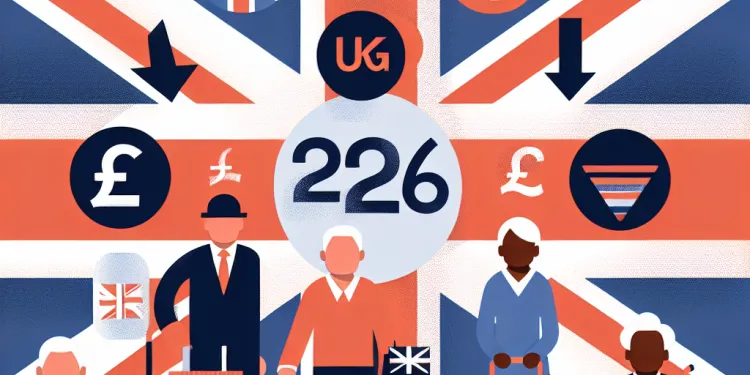
Find Help
More Items From Ergsy search
-

How will dividend taxation change in April 2026?
Relevance: 100%
-

What are HMRC Income Tax Changes in April 2026?
Relevance: 48%
-

What are the HMRC income tax changes coming into effect in April 2026?
Relevance: 45%
-

Are there changes expected for tax credits in April 2026?
Relevance: 41%
-

Are there any planned changes to tax bands for April 2026?
Relevance: 41%
-

Will there be a change in the additional rate threshold in April 2026?
Relevance: 38%
-

Is there a plan to introduce new tax initiatives in April 2026?
Relevance: 34%
-

Who will be affected by the state pension age changes in 2026?
Relevance: 28%
-

Are there further changes expected after 2026?
Relevance: 27%
-

Will the personal allowance be altered for the 2026 tax year?
Relevance: 27%
-

Is there a change in National Insurance rates for 2026?
Relevance: 26%
-

What are the state pension age changes in 2026 in the UK?
Relevance: 26%
-

What is the state pension age in the UK in 2026?
Relevance: 25%
-

Will personal savings allowances be updated in 2026?
Relevance: 24%
-

How are dividends in an ISA taxed?
Relevance: 23%
-

How soon should I prepare for the 2026 tax changes?
Relevance: 23%
-

Are there expected changes to capital gains tax in 2026?
Relevance: 23%
-

How are self-assessment taxpayers affected by the 2026 changes?
Relevance: 23%
-

Are there implications for student loan repayments with 2026 changes?
Relevance: 22%
-

UK national living wage increase 2026
Relevance: 21%
-

Will income thresholds for tax reliefs be revised in 2026?
Relevance: 20%
-

Could there be a reduction in the basic rate of income tax by 2026?
Relevance: 20%
-

Will pension contribution allowances be affected in 2026?
Relevance: 20%
-

Are there any changes to the state pension age in 2026?
Relevance: 20%
-

What is the new UK National Living Wage for 2026?
Relevance: 20%
-

What should business owners expect from income tax changes in 2026?
Relevance: 18%
-

DWP State Pension Age Changes 2026
Relevance: 16%
-

Do seniors receive any tax benefits?
Relevance: 11%
-

Does owning property abroad affect UK inheritance tax?
Relevance: 10%
-

How does a wealth tax differ from an income tax?
Relevance: 10%
-

When will the state pension age increase to 67?
Relevance: 10%
-

Are firefighter pension benefits taxable?
Relevance: 10%
-

What age group will first see the state pension age at 67?
Relevance: 9%
-

How much would I need in an ISA for a £2k monthly passive income?
Relevance: 9%
-

Can I invest in foreign stocks with an ISA?
Relevance: 9%
-

Is it necessary to complete a final tax return for the deceased?
Relevance: 9%
-

Do I need to declare my ISA income on my tax return?
Relevance: 9%
-

How does an ISA generate passive income?
Relevance: 8%
-

Would a wealth tax replace other taxes in the UK?
Relevance: 8%
-

What constitutes shareholder oppression?
Relevance: 8%
Introduction
Dividend taxation is an important consideration for investors and companies alike in the UK. Changes in dividend taxation can significantly impact investment strategies, business decisions, and personal finance planning. As we look ahead to April 2026, understanding the anticipated changes in dividend taxation will help UK taxpayers prepare effectively.
Current Landscape of Dividend Taxation
As of the current tax year, dividend income in the UK is taxed based on a tiered system. Individuals receive a dividend allowance which allows a portion of their dividend income to be tax-free. Beyond this allowance, dividend income is taxed at different rates depending on the individual's income tax band: 8.75% for basic rate taxpayers, 33.75% for higher rate taxpayers, and 39.35% for additional rate taxpayers. These rates reflect an increase introduced in April 2022.
Planned Changes for April 2026
In response to ongoing consultations and fiscal challenges, the UK government has announced intentions to revise dividend taxation from April 2026. While precise details are subject to change, several expected modifications could alter the dividend tax landscape. One expectation is a further reduction in the dividend allowance, potentially dropping from the current £1,000, reducing the amount of tax-free dividend income individuals can receive.
Additionally, discussions have indicated a potential increase in the tax rates applicable to dividends. This adjustment aims to align more closely with other forms of income taxation, which could mean a notable rise in the 8.75%, 33.75%, and 39.35% rates we see today.
Rationale Behind the Changes
The proposed changes to dividend taxation arise from the government's need to balance public finances, especially in the wake of significant expenditures from recent economic challenges such as the COVID-19 pandemic and inflationary pressures. Modifying dividend taxation is one approach to increase revenue while also addressing equity concerns, ensuring that dividend income is taxed in a manner that is comparable to other forms of income.
Implications for Taxpayers
For individual taxpayers, these changes will likely mean a higher tax burden on dividend income, particularly affecting those who rely significantly on dividends for a portion of their income. Investors will need to reassess their portfolios and potentially seek tax-efficient investment strategies to mitigate these impacts.
Companies may also face pressure to adjust their dividend policies, particularly if higher taxes reduce the attractiveness of dividends to shareholders. This could encourage businesses to consider alternative methods of returning value to shareholders, such as share buybacks, which may be more tax-efficient depending on individual circumstances.
Conclusion
Ahead of April 2026, individuals and businesses should remain informed about developing legislation concerning dividend taxation. Understanding these changes will be crucial for strategic financial planning and ensuring compliance with the new tax regulations.
Frequently Asked Questions
What are the expected changes to dividend taxation in April 2026?
The specific changes to dividend taxation in April 2026 are not yet confirmed. It is advisable to refer to government announcements or the tax authority's website closer to the date.
Will the tax rate on dividends increase in April 2026?
As of now, there are no official announcements about an increase in the tax rate on dividends in April 2026. Keep an eye on updates from the tax authorities.
How will the April 2026 dividend taxation changes affect individual investors?
Any changes in dividend taxation could impact the net return that individual investors receive from their dividend income. It's essential to review the new tax rules once they are announced.
Will there be different tax implications for domestic vs. foreign dividends in 2026?
Tax implications for domestic versus foreign dividends may vary. Check the tax authority's guidelines for any changes regarding different sources of dividends.
Are dividend tax credits expected to change in April 2026?
Information on changes to dividend tax credits has not been provided. It's important to follow updates from financial news and government announcements.
How can I find out the specific changes to dividend taxation in 2026?
The best way to stay informed about dividend taxation changes is to monitor official announcements from the government or consult with a tax professional.
Are there any proposed exemptions for dividend taxation in 2026?
Currently, there are no known proposals for new exemptions for dividend taxation in 2026. Keep an eye on legislative updates for any possible exemptions.
Will tax brackets for dividends change in April 2026?
There's no official information yet on whether dividend tax brackets will change in April 2026. Stay informed by checking government releases as the date approaches.
How should I adjust my investment strategy considering potential tax changes in 2026?
It's crucial to consult with a financial advisor to adjust your investment strategy in light of potential tax changes. They can help navigate the implications based on current knowledge and expectations.
Are changes in dividend taxation part of a broader tax reform in 2026?
It's possible that changes in dividend taxation may be part of broader tax reforms. Stay updated with the government's fiscal policies and announcements.
Will the taxation on qualified versus non-qualified dividends change?
As of now, there is no specific information on whether taxation on qualified versus non-qualified dividends will be affected in 2026. Check official sources for updates.
Could there be retroactive changes to dividend tax laws in 2026?
While governments can enact retroactive tax legislation, it's generally uncommon. However, staying informed about government proceedings is crucial to anticipate any such changes.
How might changes in dividend taxation affect corporate policies on dividends?
Changes in taxation may lead companies to adjust their dividend policies, potentially affecting payout amounts or frequency, based on taxation impact.
Will there be any changes affecting dividends from trusts or partnerships?
Details on whether dividends from trusts or partnerships will be affected have not been provided. It's advisable to monitor official announcements for any such changes.
How can international investors navigate changes in UK dividend taxation?
International investors should consult with tax experts to understand the implications of any changes in UK dividend taxation and how it affects their cross-border investments.
Are there expected changes to tax forms or reporting requirements for dividends?
If dividend taxation changes, it's possible that reporting requirements or forms may also change. Keep informed of any updates to ensure compliance.
Will the changes in April 2026 affect the dividend allowance?
As of now, no specific changes to the dividend allowance have been announced. It's important to stay updated with the news on this matter.
What resources are available to help understand the tax changes set for April 2026?
Government websites, tax authority publications, financial news outlets, and consulting with tax professionals are excellent resources to understand upcoming changes.
Why are changes to dividend taxation being considered?
Changes to dividend taxation are often considered to adjust fiscal policies, potentially increase tax revenue, or create fairer tax structures. Monitoring government releases can provide specific reasons.
Is it possible for the changes planned for April 2026 to be delayed?
While it's possible for changes to be delayed due to legislative processes or other factors, there's no information to suggest a delay at this time. Stay informed through verified channels.
Useful Links
- Ergsy carfully checks the information in the videos we provide here.
- Videos shown by Youtube after a video has completed, have NOT been reviewed by ERGSY.
- To view, click the arrow in centre of video.
- Most of the videos you find here will have subtitles and/or closed captions available.
- You may need to turn these on, and choose your preferred language.
- Go to the video you'd like to watch.
- If closed captions (CC) are available, settings will be visible on the bottom right of the video player.
- To turn on Captions, click settings .
- To turn off Captions, click settings again.
More Items From Ergsy search
-

How will dividend taxation change in April 2026?
Relevance: 100%
-

What are HMRC Income Tax Changes in April 2026?
Relevance: 48%
-

What are the HMRC income tax changes coming into effect in April 2026?
Relevance: 45%
-

Are there changes expected for tax credits in April 2026?
Relevance: 41%
-

Are there any planned changes to tax bands for April 2026?
Relevance: 41%
-

Will there be a change in the additional rate threshold in April 2026?
Relevance: 38%
-

Is there a plan to introduce new tax initiatives in April 2026?
Relevance: 34%
-

Who will be affected by the state pension age changes in 2026?
Relevance: 28%
-

Are there further changes expected after 2026?
Relevance: 27%
-

Will the personal allowance be altered for the 2026 tax year?
Relevance: 27%
-

Is there a change in National Insurance rates for 2026?
Relevance: 26%
-

What are the state pension age changes in 2026 in the UK?
Relevance: 26%
-

What is the state pension age in the UK in 2026?
Relevance: 25%
-

Will personal savings allowances be updated in 2026?
Relevance: 24%
-

How are dividends in an ISA taxed?
Relevance: 23%
-

How soon should I prepare for the 2026 tax changes?
Relevance: 23%
-

Are there expected changes to capital gains tax in 2026?
Relevance: 23%
-

How are self-assessment taxpayers affected by the 2026 changes?
Relevance: 23%
-

Are there implications for student loan repayments with 2026 changes?
Relevance: 22%
-

UK national living wage increase 2026
Relevance: 21%
-

Will income thresholds for tax reliefs be revised in 2026?
Relevance: 20%
-

Could there be a reduction in the basic rate of income tax by 2026?
Relevance: 20%
-

Will pension contribution allowances be affected in 2026?
Relevance: 20%
-

Are there any changes to the state pension age in 2026?
Relevance: 20%
-

What is the new UK National Living Wage for 2026?
Relevance: 20%
-

What should business owners expect from income tax changes in 2026?
Relevance: 18%
-

DWP State Pension Age Changes 2026
Relevance: 16%
-

Do seniors receive any tax benefits?
Relevance: 11%
-

Does owning property abroad affect UK inheritance tax?
Relevance: 10%
-

How does a wealth tax differ from an income tax?
Relevance: 10%
-

When will the state pension age increase to 67?
Relevance: 10%
-

Are firefighter pension benefits taxable?
Relevance: 10%
-

What age group will first see the state pension age at 67?
Relevance: 9%
-

How much would I need in an ISA for a £2k monthly passive income?
Relevance: 9%
-

Can I invest in foreign stocks with an ISA?
Relevance: 9%
-

Is it necessary to complete a final tax return for the deceased?
Relevance: 9%
-

Do I need to declare my ISA income on my tax return?
Relevance: 9%
-

How does an ISA generate passive income?
Relevance: 8%
-

Would a wealth tax replace other taxes in the UK?
Relevance: 8%
-

What constitutes shareholder oppression?
Relevance: 8%


